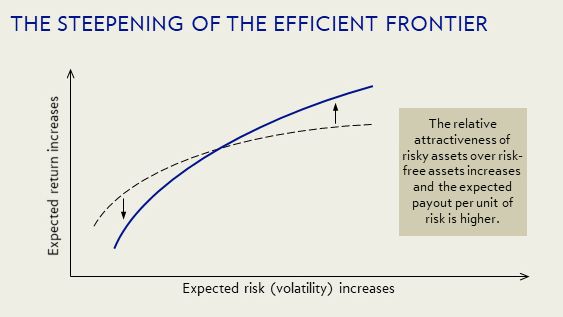

Asset allocation means dividing your portfolio into components that do not move completely in sync with one another to reduce total portfolio volatility.

The lower the correlation, the greater the benefit of blending two different indexes in a portfolio. If they move completely opposite, their correlation is -1.0. Two asset categories that move completely together have a correlation of +1.0.

This measurement is called the correlation coefficient. To look at the effects of blending these two investments together, MPT also entails knowing how much they move in sync with one another. This situates each component on the risk-return grid. MTP requires knowing the average return and standard deviation of returns for each investment component. But this is the math behind modern portfolio theory (MPT) developed in the 1950s by Harry Markowitz. Most investors are surprised that by creating a blended portfolio and rebalancing regularly, you can both lower volatility and boost returns.

Thus your total return for the two years would be 32.25%. Half the growth would experience another 30% growth the second year when investment B did better. So half of the growth from investment A is rebalanced and put into investment B. You experience a higher return because after half of your portfolio invested in A grows by 30% the first year, you rebalance your portfolio. Compounding returns would produce a total return over the two years of 32.25%. You would have both lower volatility and higher returns. Lower volatility means a more efficient portfolio. The first year you would experience a 15% return, and the second year a 15% return. Imagine a blended portfolio of half invested in A and half invested in B. And you can lower your volatility as well. It seems no matter how you mix these two investments, you can’t get more than a 30% return over two years. If you invest in either A or B, you get a 30% return over two years. Investment B goes up 0% the first year and 30% the second year. Investment A goes up 30% the first year and 0% the second year. To understand the math behind blended returns, let’s start with a simple case of two investment choices and two years. Blending a portfolio allocation can make it even more efficient by either boosting returns or lowering volatility. The efficiency of an investment is measured by the greatest return for the lowest volatility. And at the efficient frontier, the math produces nothing but curves. But CAPM is just a straight-line projection. After all, the capital asset pricing model (CAPM) suggests that return follows risk, and therefore you can’t increase return and reduce risk at the same time. Many investors don’t appreciate asset allocation or understand intuitively how a diversified portfolio can exceed the sum of its parts. And these blended portfolios can be better than any of their components. Just as a blending of colors can produce cerulean, so a blending of indexes produces a unique shade of risk and return. Crafting portfolio asset allocations is a combination of art and engineering.


 0 kommentar(er)
0 kommentar(er)
